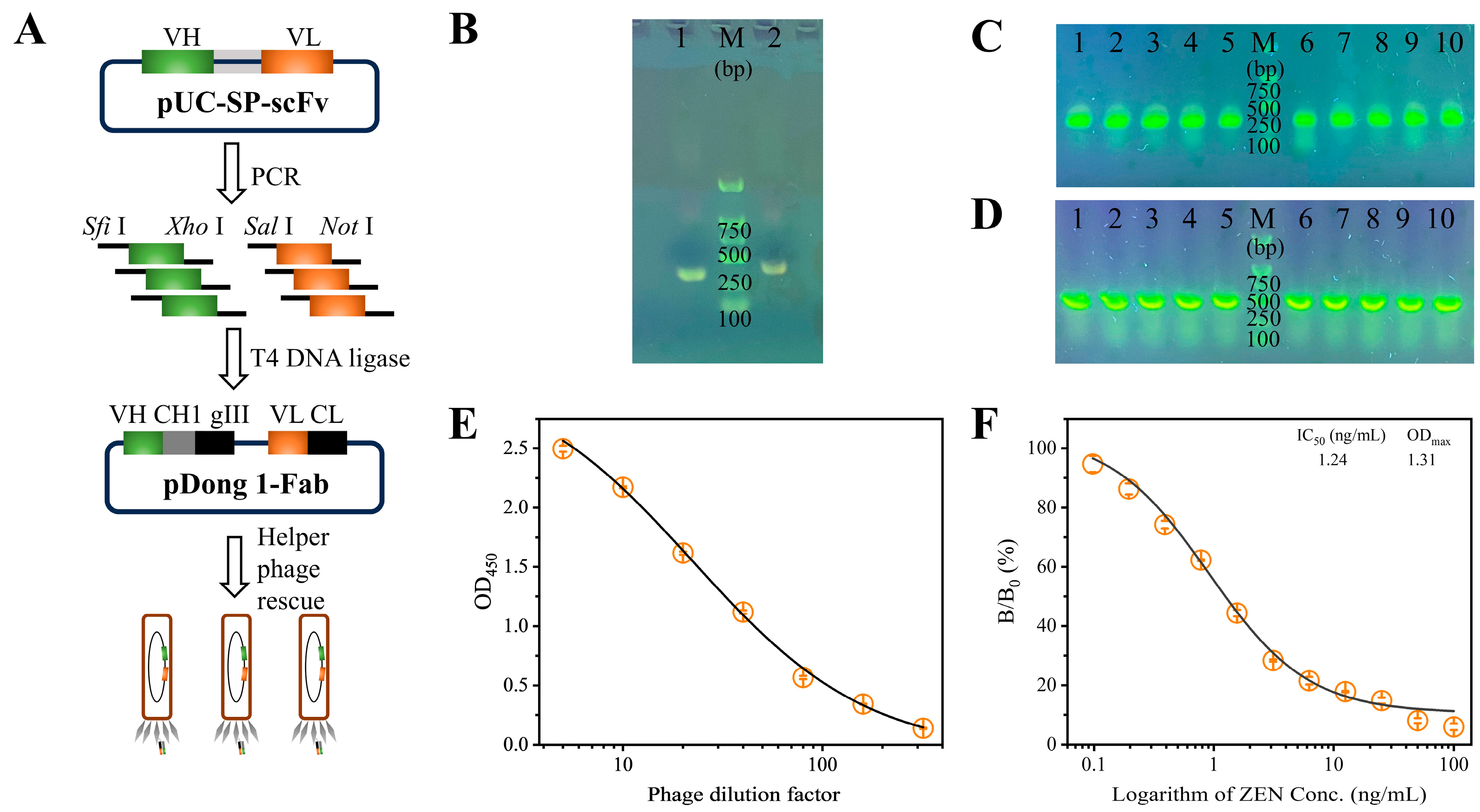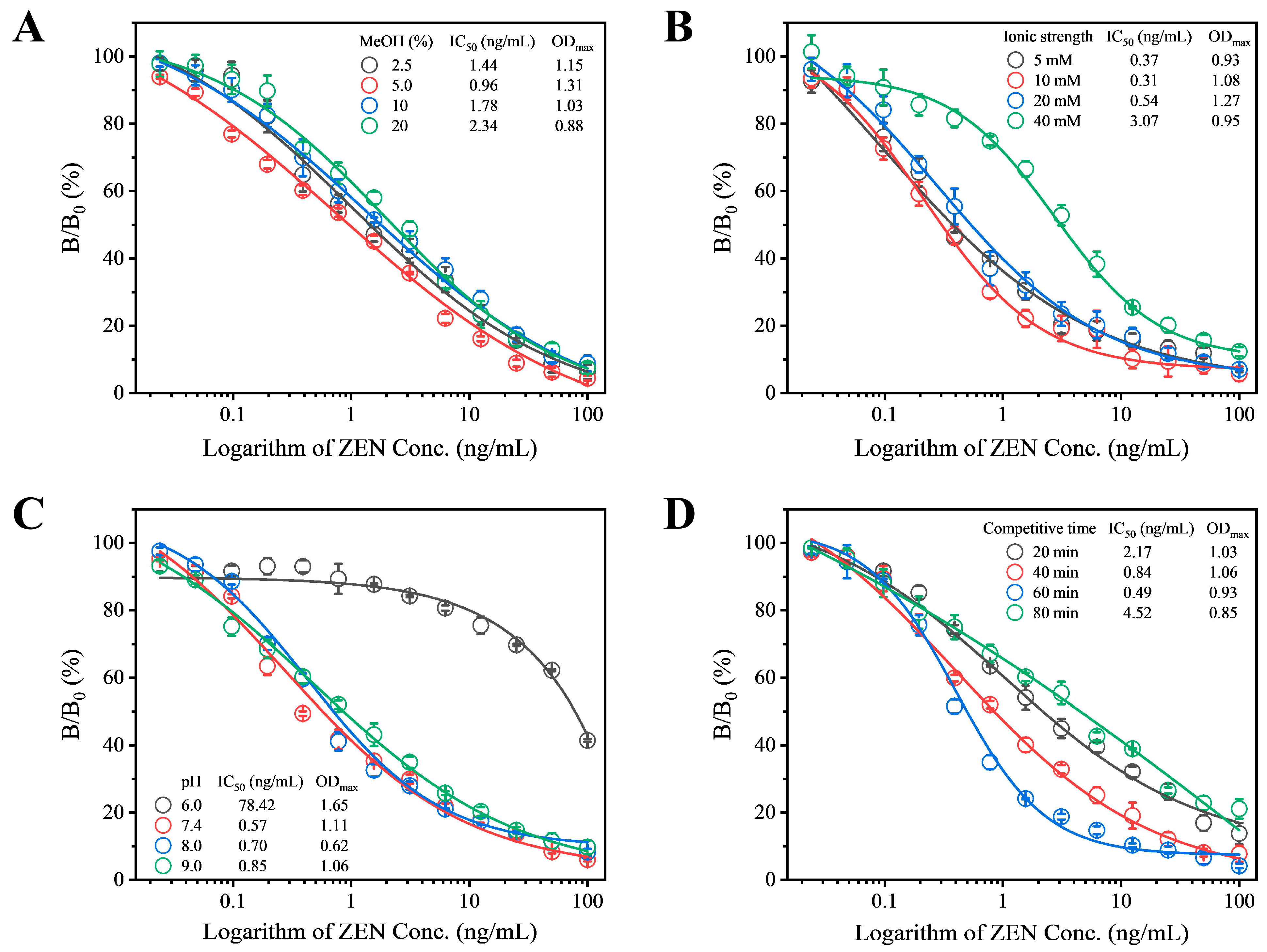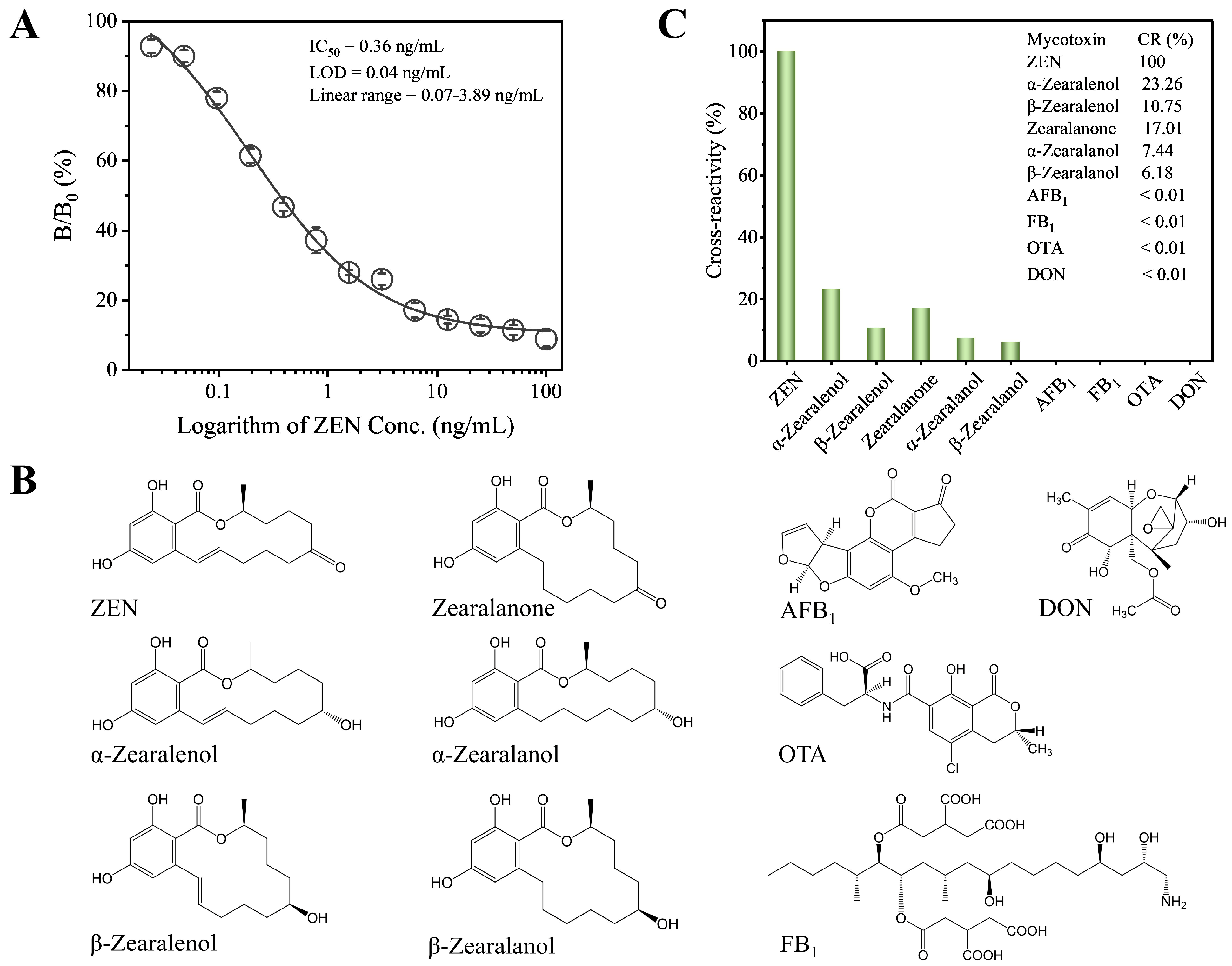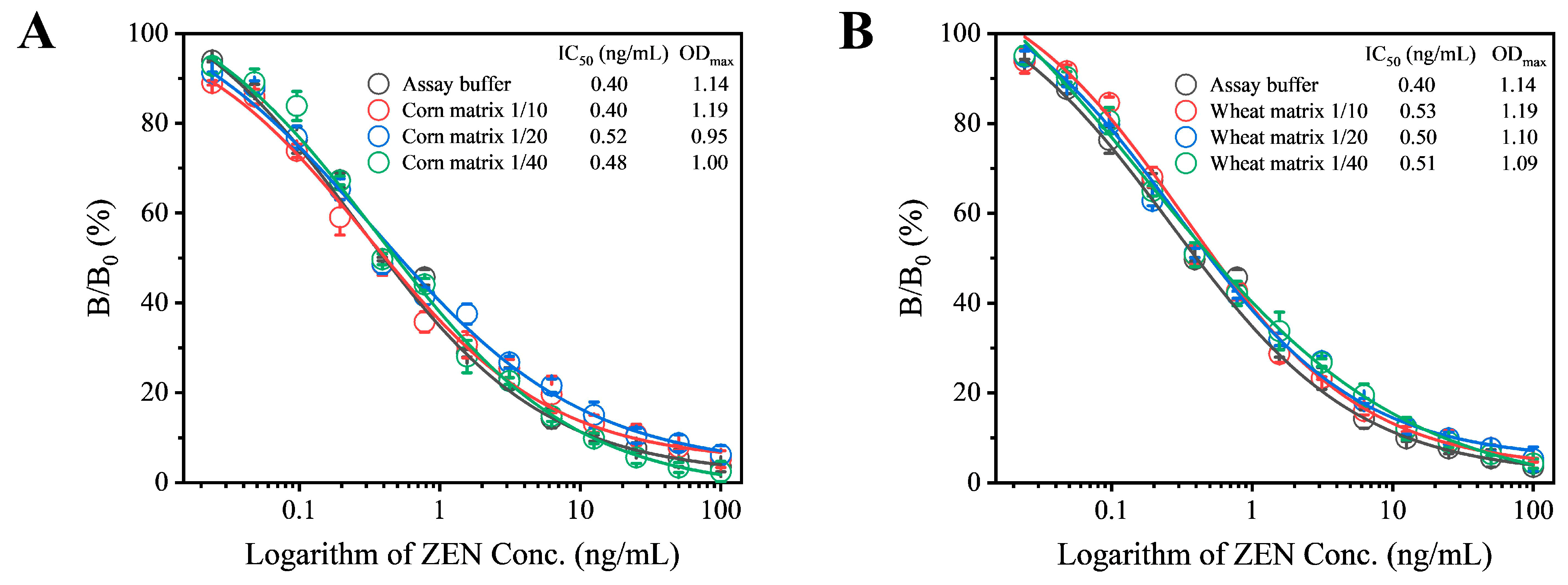Development of a Sensitive Enzyme Immunoassay Using Phage-Displayed Antigen-Binding Fragments for Zearalenone Detection in Cereal Samples
Abstract
:1. Introduction
2. Materials and Methods
2.1. Material and Reagents
2.2. Construction of pDong1-VL-VH Phagemid
2.3. Preparation and Characterization of Fab-Phage
2.4. Development of the Fab-Phage-Based ELISA for ZEN
2.5. Selectivity of the Fab-pELISA for ZEN
2.6. Analysis of Cereal Samples and Method Validation
3. Results and Discussion
3.1. Construction of pDong1-VL-VH Phagemid and the Preparation and Characterization of Fab-Phage
3.2. Optimization of Fab-pELISA for ZEN
3.3. Analytical Performance of the Fab-pELISA for ZEN
3.4. Selectivity of the Fab-pELISA
3.5. Analysis of Cereal Samples and Validation
4. Conclusions
Supplementary Materials
Author Contributions
Funding
Institutional Review Board Statement
Informed Consent Statement
Data Availability Statement
Conflicts of Interest
References
- Rai, A.; Das, M.; Tripathi, A. Occurrence and toxicity of a fusarium mycotoxin, zearalenone. Crit. Rev. Food Sci. 2020, 60, 2710–2729. [Google Scholar] [CrossRef]
- Han, X.; Huangfu, B.; Xu, T.; Xu, W.; Asakiya, C.; Huang, K.; He, X. Research progress of safety of zearalenone: A review. Toxins 2022, 14, 386. [Google Scholar] [CrossRef] [PubMed]
- Fang, Y.; Zhang, Z.; Xu, W.; Zhang, W.; Guang, C.; Mu, W. Zearalenone lactonase: Characteristics, modification, and application. Appl. Microbiol. Biot. 2022, 106, 6877–6886. [Google Scholar] [CrossRef] [PubMed]
- Abad-Fuentes, A.; Agulló, C.; López-Puertollano, D.; Navarro-Fuertes, I.; Abad-Somovilla, A.; Mercader, J.V. Alternative hapten design for zearalenone immunoreagent generation. Toxins 2022, 14, 185. [Google Scholar] [CrossRef] [PubMed]
- Kowalska, K.; Habrowska-Górczyńska, D.E.; Piastowska-Ciesielska, A.W. Zearalenone as an endocrine disruptor in humans. Environ. Toxicol. Phar. 2016, 48, 141–149. [Google Scholar] [CrossRef] [PubMed]
- Lijalem, Y.G.; Gab-Allah, M.A.; Yu, H.; Choi, K.; Kim, B. Occurrence of zearalenone and its major metabolites in cereal flour from Korea. Food Addit. Contam. A 2023, 40, 675–687. [Google Scholar] [CrossRef] [PubMed]
- Iwase, C.H.; Piacentini, K.C.; Silva, N.C.; Rebellato, A.P.; Rocha, L.O. Deoxynivalenol and zearalenone in Brazilian barley destined for brewing. Food Addit. Contam. B 2023, 16, 86–92. [Google Scholar] [CrossRef] [PubMed]
- Li, Z.; Li, Z.; Li, X.; Fan, Q.; Chen, Y.; Shi, G. “Green” Extraction and On-Site Rapid Detection of Aflatoxin B1, Zearalenone and Deoxynivalenol in Corn, Rice and Peanut. Molecules 2023, 28, 3260. [Google Scholar] [CrossRef] [PubMed]
- Sun, L.; Li, R.; Tai, B.; Hussain, S.; Wang, G.; Liu, X.; Xing, F. Current Status of Major Mycotoxins Contamination in Food and Feed in Asia—A Review. ACS Phys. Chem. Au 2023, 3, 231–244. [Google Scholar] [CrossRef]
- Balló, A.; Busznyákné Székvári, K.; Czétány, P.; Márk, L.; Török, A.; Szántó, Á.; Máté, G. Estrogenic and non-estrogenic disruptor effect of zearalenone on male reproduction: A review. Int. J. Mol. Sci. 2023, 24, 1578. [Google Scholar] [CrossRef]
- Jing, S.; Liu, C.; Zheng, J.; Dong, Z.; Guo, N. Toxicity of zearalenone and its nutritional intervention by natural products. Food Funct. 2022, 13, 10374–10400. [Google Scholar] [CrossRef]
- Ropejko, K.; Twarużek, M. Zearalenone and Its Metabolites—General Overview, Occurrence, and Toxicity. Toxins 2021, 1, 35. [Google Scholar] [CrossRef] [PubMed]
- Caglayan, M.O.; Şahin, S.; Üstündağ, Z. Detection Strategies of Zearalenone for Food Safety: A Review. Crit. Rev. Anal. Chem. 2022, 52, 294–313. [Google Scholar] [CrossRef] [PubMed]
- Ryu, D.; Hanna, M.A.; Eskridge, K.M.; Bullerman, L.B. Heat stability of zearalenone in an aqueous buffered model system. J. Agr. Food Chem. 2003, 51, 1746–1748. [Google Scholar] [CrossRef]
- Gajęcki, M.T.; Gajęcka, M. The Multidirectional Influence of Feed-Borne Deoxynivalenol and Zearalenone on Animal Health. Toxins 2023, 15, 419. [Google Scholar] [CrossRef] [PubMed]
- Alexander, J.; Dall Asta, C.; Gutleb, A.C.; Metzler, M.; Oswald, I.; Parent Massin, D.; Steinkellner, H. EFSA’s integrated approach to set a tolerable daily intake for zearalenone and its modified forms. Toxicol. Lett. 2016, 258, S311–S312. [Google Scholar] [CrossRef]
- Mally, A.; Solfrizzo, M.; Degen, G.H. Biomonitoring of the mycotoxin Zearalenone: Current state-of-the art and application to human exposure assessment. Arch. Toxicol. 2016, 90, 1281–1292. [Google Scholar] [CrossRef]
- Schaarschmidt, S.; Fauhl-Hassek, C. The Fate of Mycotoxins During the Processing of Wheat for Human Consumption. Compr. Rev. Food Sci. Food Saf. 2018, 17, 556–593. [Google Scholar] [CrossRef] [PubMed]
- Koch, M.; Mauch, T.; Riedel, J. Development of a Hydrazine-Based Solid-Phase Extraction and Clean-Up Method for Highly Selective Quantification of Zearalenone in Edible Vegetable Oils by HPLC-FLD. Toxins 2022, 14, 549. [Google Scholar] [CrossRef] [PubMed]
- Guan, X.; Feng, Y.; Suo, D.; Xiao, Z.; Wang, S.; Liang, Y.; Fan, X. Simultaneous Determination of 11 Mycotoxins in Maize via Multiple-Impurity Adsorption Combined with Liquid Chromatography–Tandem Mass Spectrometry. Foods 2022, 11, 3624. [Google Scholar] [CrossRef] [PubMed]
- Pack, E.; Stewart, J.; Rhoads, M.; Knight, J.; De Vita, R.; Clark-Deener, S.; Schmale, D.G. Quantification of zearalenone and α-zearalenol in swine liver and reproductive tissues using GC-MS. Toxicon X 2020, 8, 100058. [Google Scholar] [CrossRef]
- Hua, X.; Liu, X.; Shi, H.; Wang, Y.; Kim, H.J.; Gee, S.J.; Wang, M.; Liu, F.; Hammock, B.D. Development of a heterologous enzyme-linked immunosorbent assay for organophosphorus pesticides with phage-borne peptide. RSC Adv. 2014, 4, 42445–42453. [Google Scholar] [CrossRef] [PubMed]
- Sompunga, P.; Pruksametanan, N.; Rangnoi, K.; Choowongkomon, K.; Yamabhai, M. Generation of human and rabbit recombinant antibodies for the detection of Zearalenone by phage display antibody technology. Talanta 2019, 201, 397–405. [Google Scholar] [CrossRef]
- Shi, L.; Yu, T.; Luo, M.; Wang, H. Preparation monoclonal β-type anti-idiotype antibody of zearalenone and development of green ELISA quantitative detecting technique. Prep. Biochem. Biotech. 2019, 50, 419–424. [Google Scholar] [CrossRef]
- Zhang, Q.; Zhang, X.; Zhang, G.; Chen, W.; Wu, S.; Yang, H.; Zhou, Y. Multicolor immunosensor for detection of zearalenone based on etching Au NBPs mediated by HRP. J. Food Compos. Anal. 2023, 115, 105014. [Google Scholar] [CrossRef]
- Cancelliere, R.; Di Tinno, A.; Cataldo, A.; Bellucci, S.; Kumbhat, S.; Micheli, L. Nafion-based label-free immunosensor as a reliable warning system: The case of AFB1 detection in cattle feed. Microchem. J. 2023, 191, 108868. [Google Scholar] [CrossRef]
- Zhang, X.; Tang, Q.; Mi, T.; Zhao, S.; Wen, K.; Guo, L.; Mi, J.; Zhang, S.; Shi, W.; Shen, J.; et al. Dual-wavelength fluorescence polarization immunoassay to increase information content per screen: Applications for simultaneous detection of total aflatoxins and family zearalenones in maize. Food Control 2018, 87, 100–108. [Google Scholar] [CrossRef]
- Jiang, X.; Li, X.; Yang, Z.; Eremin, S.A.; Zhang, X. Evaluation and Optimization of Three Different Immunoassays for Rapid Detection Zearalenone in Fodders. Food Anal. Method. 2017, 10, 256–262. [Google Scholar] [CrossRef]
- Chen, Y.; Fu, Q.; Xie, J.; Wang, H.; Tang, Y. Development of a high sensitivity quantum dot-based fluorescent quenching lateral flow assay for the detection of zearalenone. Anal. Bioanal. Chem. 2019, 411, 2169–2175. [Google Scholar] [CrossRef] [PubMed]
- Liu, G.; Han, Z.; Nie, D.; Yang, J.; Zhao, Z.; Zhang, J.; Li, H.; Liao, Y.; Song, S.; De Saeger, S.; et al. Rapid and sensitive quantitation of zearalenone in food and feed by lateral flow immunoassay. Food Control 2012, 27, 200–205. [Google Scholar] [CrossRef]
- Mollarasouli, N.; Kurbanoglu, N.; Ozkan, N. The Role of Electrochemical Immunosensors in Clinical Analysis. Biosensors 2019, 9, 86. [Google Scholar] [CrossRef] [PubMed]
- Shimizu, Y.; Shinoda, T.; Shirasago, Y.; Kondoh, M.; Shinya, N.; Hanada, K.; Yagi, K.; Suzuki, T.; Wakita, T.; Kimura-Someya, T.; et al. Occludin-binding single-chain variable fragment and antigen-binding fragment antibodies prevent hepatitis C virus infection. Febs. Lett. 2021, 595, 220–229. [Google Scholar] [CrossRef]
- Quintero-Hernández, V.; Juárez-González, V.R.; Ortíz-León, M.; Sánchez, R.; Possani, L.D.; Becerril, B. The change of the scFv into the Fab format improves the stability and in vivo toxin neutralization capacity of recombinant antibodies. Mol. Immunol. 2007, 44, 1307–1315. [Google Scholar] [CrossRef] [PubMed]
- Victor, C.; Michael, T. Aptamers, antibody scFv, and antibody Fab’ fragments: An overview and comparison of three of the most versatile biosensor biorecognition elements. Biosens. Bioelectron. 2016, 85, 32–45. [Google Scholar]
- Holliger, P.; Hudson, P.J. Engineered antibody fragments and the rise of single domains. Nat. Biotechnol. 2005, 23, 1126–1136. [Google Scholar] [CrossRef] [PubMed]
- Rao, M.F.; Li, Y.J.; Dong, J.X.; Wu, W.J.; Xu, Z.L.; Sun, Y.M.; Wang, H. Production and characterization of a single-chain Fab fragment for the detection of O,O-diethyl organophosphorus pesticides. Anal. Methods 2016, 8, 3140–3147. [Google Scholar] [CrossRef]
- Chen, Z.; Zhang, X.; Wang, B.; Rao, M.; Wang, H.; Lei, H.; Liu, H.; Zhang, Y.; Sun, Y.; Xu, Z. Production of Antigen-Binding Fragment against O,O-Diethyl Organophosphorus Pesticides and Molecular Dynamics Simulations of Antibody Recognition. Int. J. Mol. Sci. 2018, 19, 1381. [Google Scholar] [CrossRef] [PubMed]
- Barderas, R.; Benito-Peña, E. The 2018 Nobel Prize in Chemistry: Phage display of peptides and antibodies. Anal. Bioanal. Chem. 2019, 411, 2475–2479. [Google Scholar] [CrossRef]
- Smith, G.P. Filamentous fusion phage: Novel expression vectors that display cloned antigens on the virion surface. Science 1985, 228, 1315–1317. [Google Scholar] [CrossRef] [PubMed]
- Frenzel, A.; Schirrmann, T.; Hust, M. Phage display-derived human antibodies in clinical development and therapy. mAbs 2016, 8, 1177–1194. [Google Scholar] [CrossRef]
- Shukra, A.M.; Sridevi, N.V.; Chandran, D.; Maithal, K. Production of recombinant antibodies using bacteriophages. Eur. J. Microbiol. Immu. 2014, 4, 91–98. [Google Scholar] [CrossRef] [PubMed]
- Guliy, O.I.; Evstigneeva, S.S.; Khanadeev, V.A.; Dykman, L.A. Antibody Phage Display Technology for Sensor-Based Virus Detection: Current Status and Future Prospects. Biosensors 2023, 13, 640. [Google Scholar] [CrossRef]
- Ledsgaard, L.; Kilstrup, M.; Karatt-Vellatt, A.; McCafferty, J.; Laustsen, A.H. Basics of Antibody Phage Display Technology. Toxins 2018, 6, 236. [Google Scholar] [CrossRef] [PubMed]
- Qiu, J.; Li, J.; Zhang, Z.; Dong, S.; Ling, X.; Fang, Z.; Ling, Q.; Huang, Z. Construction of an alpaca immune antibody library for the selection of nanobodies against Drosophila melanogaster proteins. Front. Bioeng. Biotech. 2023, 11, 1207048. [Google Scholar] [CrossRef] [PubMed]
- Manoutcharian, K.; Gevorkian, G. Shark VNAR phage display libraries: An alternative source for therapeutic and diagnostic recombinant antibody fragments. Fish Shellfish. Immun. 2023, 138, 108808. [Google Scholar] [CrossRef]
- Dong, Y.; Meng, F.; Wang, Z.; Yu, T.; Chen, A.; Xu, S.; Wang, J.; Yin, M.; Tang, L.; Hu, C.; et al. Construction and application of a human scFv phage display library based on Cre-LoxP recombination for anti-PCSK9 antibody selection. Int. J. Mol. Med. 2021, 47, 708–718. [Google Scholar] [CrossRef]
- Nelson, R.S.; Valadon, P. A universal phage display system for the seamless construction of Fab libraries. J. Immunol. Methods 2017, 450, 41–49. [Google Scholar] [CrossRef] [PubMed]
- Zhao, F.; Wang, G.; Cao, X.; Song, W.; Guo, M.; Wang, H.; Yang, Z. Non-competitive immunoassay for zearalenone based on phage display developed recombinant antibody and anti-immunocomplex peptide. Food Chem. 2025, 472, 142943. [Google Scholar] [CrossRef] [PubMed]
- Zhang, B.; Li, H.; Li, Y.; Fu, X.; Du, D. A sensitive chemiluminescence immunoassay based on immunomagnetic beads for quantitative detection of zearalenone. Eur. Food Res. Technol. 2021, 247, 2171–2181. [Google Scholar] [CrossRef]
- Ma, T.; Liu, K.; Yang, X.; Yang, J.; Pan, M.; Wang, S. Development of Indirect Competitive ELISA and Visualized Multicolor ELISA Based on Gold Nanorods Growth for the Determination of Zearalenone. Foods 2021, 10, 2654. [Google Scholar] [CrossRef]
- Wang, Y.; Wang, X.; Wang, S.; Fotina, H.; Wang, Z. Development of a Highly Sensitive and Specific Monoclonal Antibody Based on Indirect Competitive Enzyme-Linked Immunosorbent Assay for the Determination of Zearalenone in Food and Feed Samples. Toxins 2022, 14, 220. [Google Scholar] [CrossRef] [PubMed]
- Xu, S.; Zhang, G.; Fang, B.; Xiong, Q.; Duan, H.; Lai, W. Lateral Flow Immunoassay Based on Polydopamine-Coated Gold Nanoparticles for the Sensitive Detection of Zearalenone in Maize. ACS Appl. Mater. Inter. 2019, 11, 31283–31290. [Google Scholar] [CrossRef]
- Zhao, F.; Shen, Q.; Wang, H.; Han, X.; Yang, Z. Development of a rapid magnetic bead-based immunoassay for sensitive detection of zearalenone. Food Control 2017, 79, 227–233. [Google Scholar] [CrossRef]
- Zhou, J.; Wang, X.; Li, Y.; Chen, Y.; Liu, Y.; Liu, H.; Liang, C.; Zhu, X.; Qi, Y.; Wang, A. Fluorescence immunoassay based on phage mimotope for nontoxic detection of Zearalenone in maize. J. Food Saf. 2022, 42, e12982. [Google Scholar] [CrossRef]
- Zhan, S.; Huang, X.; Chen, R.; Li, J.; Xiong, Y. Novel fluorescent ELISA for the sensitive detection of zearalenone based on H2O2-sensitive quantum dots for signal transduction. Talanta 2016, 158, 51–56. [Google Scholar] [CrossRef] [PubMed]
- Peltomaa, R.; Farka, Z.; Mickert, M.J.; Brandmeier, J.C.; Pastucha, M.; Hlaváček, A.; Martínez-Orts, M.; Canales, Á.; Skládal, P.; Benito-Peña, E.; et al. Competitive upconversion-linked immunoassay using peptide mimetics for the detection of the mycotoxin zearalenone. Biosen. Bioelectron. 2020, 170, 112683. [Google Scholar] [CrossRef] [PubMed]
- Yang, Q.; Qi, Y.; Zhou, J.; Liu, H.; Liu, Y.; Chen, Y.; Liang, C.; Wang, A. Development of Fluorescent Immunochromatographic Test Strip for Qualitative and Quantitative Detection of Zearalenone. Food Anal. Method. 2022, 15, 2547–2557. [Google Scholar] [CrossRef]
- Tang, X.; Li, P.; Zhang, Q.; Zhang, Z.; Zhang, W.; Jiang, J. Time-Resolved Fluorescence Immunochromatographic Assay Developed Using Two Idiotypic Nanobodies for Rapid, Quantitative, and Simultaneous Detection of Aflatoxin and Zearalenone in Maize and Its Products. Anal. Chem. 2017, 89, 11520–11528. [Google Scholar] [CrossRef]
- Wang, X.; He, Q.; Xu, Y.; Liu, X.; Shu, M.; Tu, Z.; Li, Y.; Wang, W.; Cao, D. Anti-idiotypic VHH phage display-mediated immuno-PCR for ultrasensitive determination of mycotoxin zearalenone in cereals. Talanta 2016, 147, 410–415. [Google Scholar] [CrossRef] [PubMed]
- Liu, R.; Shi, R.; Zou, W.; Chen, W.; Yin, X.; Zhao, F.; Yang, Z. Highly sensitive phage-magnetic-chemiluminescent enzyme immunoassay for determination of zearalenone. Food Chem. 2020, 325, 126905. [Google Scholar] [CrossRef] [PubMed]
- Peltomaa, R.; Fikacek, S.; Benito-Peña, E.; Barderas, R.; Head, T.; Deo, S.; Daunert, S.; Moreno-Bondi, M.C. Bioluminescent detection of zearalenone using recombinant peptidomimetic Gaussia luciferase fusion protein. Microchim. Acta 2020, 170, 112683. [Google Scholar] [CrossRef] [PubMed]
- Liu, X.; Li, J.; Chen, R.; Xie, X.; Mao, F.; Sun, Z.; He, Z.; Cao, H.; Zhang, S.; Liu, X. Colorimetric and chemiluminescent enzyme immunoassays based on the alkaline phosphatase-tagged single-chain variable fragment fusion tracer for detecting zearalenone in agro-products. Food Chem. 2024, 443, 138569. [Google Scholar] [CrossRef]





| Methods | Used Materials | IC50 (ng/mL) | LOD (ng/mL) | Refs. |
|---|---|---|---|---|
| ELISA | scFv | 90 | 20 | [23] |
| ELISA | mAb, gold nanorod | 0.85 | 0.22 | [50] |
| ELISA | mAb | 8.69 | 0.76 | [51] |
| LFIA | mAb, polydopamine-coated gold nanoparticles | - | 0.0074 | [52] |
| MB-ELISA | mAb, magnetic bead | 1.78 | 0.13 | [53] |
| Fluorescent ELISA | mAb, phage mimotope, quantum dot | 0.301 | 0.023 | [54] |
| Fluorescent ELISA | mAb, quantum dot | 0.075 | 0.0041 | [55] |
| Fluorescent ELISA | mAb, mimotope peptide, upconversion nanoparticles | 0.16 | 0.02 | [56] |
| Fluorescent LFIA | mAb, quantum dot | 2.792 | 0.273 | [57] |
| Fluorescent LFIA | mAb, quantum dot | - | 0.58 | [29] |
| Fluorescent LFIA | mAb, anti-idiotypic nanobody, Eu/Tb(III) nanosphere | 0.52 | 0.07 | [58] |
| Immuno-PCR | mAb, phage-displayed anti-idiotypic nanobody | 0.257 | 0.08 | [59] |
| Chemiluminescent ELISA | mAb, phage mimotope, magnetic bead | 0.0314 | 0.0043 | [60] |
| Bioluminescent immunosensor | mAb, mimotope peptide-Gaussia luciferase fusion protein, protein G–coupled magnetic beads | 11.0 | 4.2 | [61] |
| pELISA | Fab-phage | 0.36 | 0.03 | This work |
| Sample | Spiked Level (µg/kg) | Intra-Assay (n = 3) a | Inter-Assay (n = 3) b | ||||
|---|---|---|---|---|---|---|---|
| Mean ± SD (µg/kg) | Recovery (%) | RSD (%) | Mean ± SD (µg/kg) | Recovery (%) | RSD (%) | ||
| Corn | 10 | 10.73 ± 0.20 | 107.33 | 1.89 | 12.06 ± 0.16 | 120.64 | 1.33 |
| 20 | 20.65 ± 0.43 | 103.28 | 2.11 | 20.06 ± 0.39 | 100.32 | 1.99 | |
| 40 | 41.77 ± 1.01 | 104.43 | 2.42 | 42.00 ± 1.10 | 105.02 | 2.63 | |
| Wheat | 10 | 11.56 ± 0.15 | 115.60 | 1.29 | 12.26 ± 0.13 | 122.66 | 1.12 |
| 20 | 22.38 ± 0.29 | 111.90 | 1.27 | 19.47 ± 0.36 | 97.35 | 3.28 | |
| 40 | 39.44 ± 1.25 | 98.60 | 3.17 | 44.34 ± 0.89 | 110.86 | 2.02 | |
| Sample | Fab-pELISA (n = 3) | HPLC (n = 3) [62] | ||
|---|---|---|---|---|
| Mean ± SD (µg/kg) | RSD (%) | Mean ± SD (µg/kg) | RSD (%) | |
| Wheat-1 | 7.60 ± 0.11 | 1.45 | 8.21 ± 0.52 | 6.33 |
| Wheat-2 | Not detected | - | Not detected | - |
| Wheat-3 | 4.59 ± 0.01 | 0.22 | 5.40 ± 0.08 | 1.48 |
| Wheat-4 | 10.66 ± 0.23 | 2.16 | 9.53 ± 0.38 | 3.99 |
| Wheat-5 | 141.95 ± 1.70 | 1.20 | 129.11 ± 1.04 | 0.81 |
| Wheat-6 | 142.42 ± 1.34 | 0.94 | 149.01 ± 3.14 | 2.11 |
| Wheat-7 | 12.31 ± 0.25 | 2.03 | 11.83 ± 0.17 | 1.44 |
| Wheat-8 | 211.02 ± 5.38 | 2.55 | 199.74 ± 2.38 | 1.19 |
| Wheat-9 | 168.55 ± 4.70 | 2.79 | 164.21 ± 2.35 | 1.43 |
| Wheat-10 | 180.62 ± 2.21 | 1.22 | 186.36 ± 4.90 | 2.63 |
| Corn-1 | Not detected | - | Not detected | - |
| Corn-2 | 33.62 ± 0.67 | 1.99 | 27.33 ± 0.36 | 1.32 |
| Corn-3 | 6.56 ± 0.13 | 1.98 | 7.22 ± 0.42 | 5.82 |
| Corn-4 | 32.39 ± 0.99 | 3.06 | 33.18 ± 0.93 | 2.80 |
| Corn-5 | 738.96 ± 6.88 | 0.93 | 745.54 ± 20.31 | 2.72 |
| Corn-6 | 83.12 ± 1.72 | 2.07 | 95.95 ± 6.43 | 6.70 |
Disclaimer/Publisher’s Note: The statements, opinions and data contained in all publications are solely those of the individual author(s) and contributor(s) and not of MDPI and/or the editor(s). MDPI and/or the editor(s) disclaim responsibility for any injury to people or property resulting from any ideas, methods, instructions or products referred to in the content. |
© 2025 by the authors. Licensee MDPI, Basel, Switzerland. This article is an open access article distributed under the terms and conditions of the Creative Commons Attribution (CC BY) license (https://creativecommons.org/licenses/by/4.0/).
Share and Cite
Chen, Y.; Liu, X.; Li, J.; Liu, X. Development of a Sensitive Enzyme Immunoassay Using Phage-Displayed Antigen-Binding Fragments for Zearalenone Detection in Cereal Samples. Foods 2025, 14, 746. https://doi.org/10.3390/foods14050746
Chen Y, Liu X, Li J, Liu X. Development of a Sensitive Enzyme Immunoassay Using Phage-Displayed Antigen-Binding Fragments for Zearalenone Detection in Cereal Samples. Foods. 2025; 14(5):746. https://doi.org/10.3390/foods14050746
Chicago/Turabian StyleChen, Ying, Xinmiao Liu, Jiao Li, and Xing Liu. 2025. "Development of a Sensitive Enzyme Immunoassay Using Phage-Displayed Antigen-Binding Fragments for Zearalenone Detection in Cereal Samples" Foods 14, no. 5: 746. https://doi.org/10.3390/foods14050746
APA StyleChen, Y., Liu, X., Li, J., & Liu, X. (2025). Development of a Sensitive Enzyme Immunoassay Using Phage-Displayed Antigen-Binding Fragments for Zearalenone Detection in Cereal Samples. Foods, 14(5), 746. https://doi.org/10.3390/foods14050746





